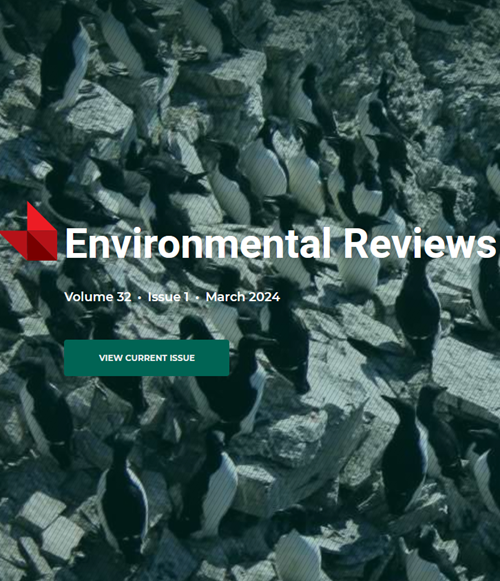森林采伐对温带小型湖泊的影响综述
IF 5.1
3区 环境科学与生态学
Q2 ENVIRONMENTAL SCIENCES
引用次数: 0
摘要
小湖泊(小于1平方公里)通过水文、陆地和空中的物质输送,在物理、化学和生物上与其流域联系在一起。影响湖泊功能和结构的输入,如养分、能量、沉积物和大量木材补贴,在三个空间尺度上到达湖泊,即湖泊流域、湖泊流入流和湖泊河岸区。湖泊是水景的水槽,整合了来自景观的累积输入。因此,湖泊可以对森林采伐等景观干扰作出反应。森林采伐和相关活动可引起流域水量、湖泊的有机和无机物质输入以及湖泊温度和风的变化。这些变化会导致压力源,从而改变湖泊的自然栖息地、水质和食物网。在此,我们回顾了森林采伐对温带小湖泊的影响。湖泊对采伐的响应程度可能取决于诸如流域采伐的比例、采伐的强度、造林实践和其他活动以及道路建设和密度等因素。其他附加因素包括湖泊靠近采伐,以及它对连接受干扰地区与河流和湖泊系统的水文路径的影响。大多数被调查的研究报告了短期内营养和能量投入的增加,由于收获而增加的沉积,以及风速的增加,其中大约一半报告了初级产量的增加或浮游动物生物量的减少。底栖大型无脊椎动物、鱼类和两栖动物的结果报告较少,且地理上存在差异。湖泊食物网响应方向和强度的变化很可能是由于对具有不同流域特征和林业活动的湖泊进行了研究,这些特征和活动会影响湖泊响应的强度(即流域采伐的比例、林业作业方法、与湖泊的水文联系以及地点特定属性)。我们还讨论了在减少林业对湖泊影响的背景下,流域林业管理和湖岸河岸缓冲带的实施。大多数研究都是短期的,而森林采伐对湖泊生态系统的长期累积影响尚不清楚。本文章由计算机程序翻译,如有差异,请以英文原文为准。
Forest harvesting impacts on small, temperate zone lakes: a review
Small lakes (< 1 km2) are physically, chemically, and biologically linked to their watersheds through hydrologic, terrestrial, and aerial delivery of materials. Inputs affecting lake function and structure, such as nutrient, energy, sediment, and large wood subsidies, arrive at the lake on three spatial scales, i.e., the lake watershed, lake-inflow streams, and lake riparian areas. Lakes are sinks in the waterscape and integrate cumulative inputs from the landscape. Lakes can therefore react to landscape disturbances such as forest harvesting. Forest harvesting and associated activities can induce changes in watershed water yields, inputs of organic and inorganic materials to lakes, and in lake temperatures and wind. These changes result in stressors that can alter the lake’s physical habitat, water quality, and food webs. Here we review the reported impacts of forest harvesting on small, temperate zone lakes. The magnitude of the lake response to harvesting can depend on factors such as the proportion of the watershed harvested, the intensity of this harvesting, silvicultural practices and other activities, and road construction and density. Other additional factors include the proximity of the lake to harvesting and its impact on hydrological pathways connecting perturbed areas to stream and lake systems. The majority of surveyed studies reported short-term increases in nutrient and energy inputs, increased sedimentation due to harvesting, and increases in wind speeds, where about half reported increases in primary production or decreases in zooplankton biomass. Results on benthic macroinvertebrate, fish, and amphibians were less frequently reported and were geographically variable. Variation in the direction and magnitude of a lake’s food web response is likely due to studies of lakes with differences in watershed characteristics and forestry activities that can affect the magnitude of the lake response (i.e., proportion of watershed harvesting, forestry operations methods, hydrological connections to the lake, and site-specific attributes). We also discuss watershed forestry management and the implementation of lakeshore riparian buffers in the context of reducing forestry impacts on lakes. Most studies have been short-term, and the long-term, cumulative effects of forest harvesting on lake ecosystems remain unclear.
求助全文
通过发布文献求助,成功后即可免费获取论文全文。
去求助
来源期刊

Environmental Reviews
环境科学-环境科学
自引率
3.50%
发文量
45
期刊介绍:
Published since 1993, Environmental Reviews is a quarterly journal that presents authoritative literature reviews on a wide range of environmental science and associated environmental studies topics, with emphasis on the effects on and response of both natural and manmade ecosystems to anthropogenic stress. The authorship and scope are international, with critical literature reviews submitted and invited on such topics as sustainability, water supply management, climate change, harvesting impacts, acid rain, pesticide use, lake acidification, air and marine pollution, oil and gas development, biological control, food chain biomagnification, rehabilitation of polluted aquatic systems, erosion, forestry, bio-indicators of environmental stress, conservation of biodiversity, and many other environmental issues.
 求助内容:
求助内容: 应助结果提醒方式:
应助结果提醒方式:


